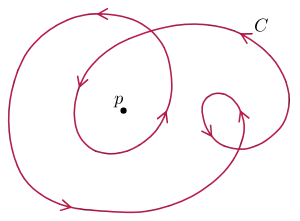Regular homotopy
In the mathematical field of topology, a regular homotopy refers to a special kind of homotopy between immersions of one manifold in another. The homotopy must be a 1-parameter family of immersions.
Similar to homotopy classes, one defines two immersions to be in the same regular homotopy class if there exists a regular homotopy between them. Regular homotopy for immersions is similar to isotopy of embeddings: they are both restricted types of homotopies. Stated another way, two continuous functions are homotopic if they represent points in the same path-components of the mapping space , given the compact-open topology. The space of immersions is the subspace of consisting of immersions, denote it by . Two immersions are regularly homotopic if they represent points in the same path-component of .
Examples

The Whitney–Graustein theorem classifies the regular homotopy classes of a circle into the plane; two immersions are regularly homotopic if and only if they have the same turning number – equivalently, total curvature; equivalently, if and only if their Gauss maps have the same degree/winding number.

Stephen Smale classified the regular homotopy classes of a k-sphere immersed in – they are classified by homotopy groups of Stiefel manifolds, which is a generalization of the Gauss map, with here k partial derivatives not vanishing. More precisely, the set of regular homotopy classes of embeddings of sphere in is in one-to-one correspondence with elements of group . In case we have . Since is path connected, and and due to Bott periodicity theorem we have and since then we have . Therefore all immersions of spheres and in euclidean spaces of one more dimension are regular homotopic. In particular, spheres embedded in admit eversion if . A corollary of his work is that there is only one regular homotopy class of a 2-sphere immersed in . In particular, this means that sphere eversions exist, i.e. one can turn the 2-sphere "inside-out".
Both of these examples consist of reducing regular homotopy to homotopy; this has subsequently been substantially generalized in the homotopy principle (or h-principle) approach.
References
- Whitney, Hassler (1937). "On regular closed curves in the plane". Compositio Mathematica. 4: 276–284.
- Smale, Stephen (February 1959). "A classification of immersions of the two-sphere" (PDF). Transactions of the American Mathematical Society. 90 (2): 281–290. doi:10.2307/1993205. JSTOR 1993205.
- Smale, Stephen (March 1959). "The classification of immersions of spheres in Euclidean spaces" (PDF). Annals of Mathematics. 69 (2): 327–344. doi:10.2307/1970186. JSTOR 1970186.